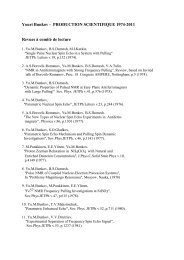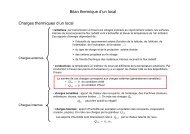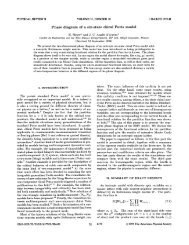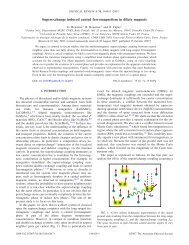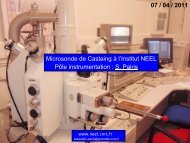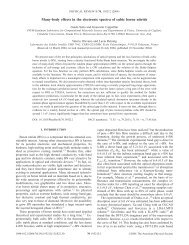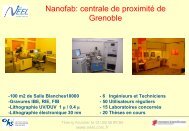Activity Report 2010 - CNRS
Activity Report 2010 - CNRS
Activity Report 2010 - CNRS
You also want an ePaper? Increase the reach of your titles
YUMPU automatically turns print PDFs into web optimized ePapers that Google loves.
Innovative biochips to<br />
detect and screen biological<br />
cells<br />
“Fil de l’eau” PhD student 2008:<br />
Radoslaw BOMBERA<br />
Thesis Directors: Thierry LIVACHE and<br />
Yann ROUPIOZ (INAC/SPrAM).<br />
The biological matter is a complex<br />
mixture of cells and molecules. Selective<br />
capture and release are therefore<br />
necessary to sort and analyze cells, in the<br />
blood for instance. In this project, living<br />
cells are reversibly adsorbed on a<br />
functionalized surface.<br />
This technique could provide a low-cost<br />
alternative to flow cytometry methods,<br />
currently used in biology and medicine to<br />
quantitatively analyze cell mixtures.<br />
The development of these new biochips<br />
combines different innovations:<br />
using complementary DNA<br />
strands to immobilize antibodies onto<br />
surfaces; these antibodies can selectively<br />
capture cells entering in contact with the<br />
biochip surface.<br />
locally heating up the surface to<br />
dissociate DNA strands and releasing<br />
cells; cells and molecules are both<br />
detected by surface plasmon resonance<br />
imaging.<br />
Figure 5 shows a proof-of-concept<br />
experiment. Three different probes are<br />
used. The first two ones allow antibodies<br />
to be immobilized, that in turn capture B<br />
and T lymphocytes, respectively. The last<br />
one is a negative control. The relative<br />
reflectivity of a gold surface, which is<br />
related to the mass adsorbed to the<br />
surface of the biochip, is measured in<br />
real-time.<br />
In a) the coupling DNA strands bind to<br />
the DNA probes, in b) the antibodies are<br />
immobilized, in c) the cells are captured.<br />
In d) and e) they are selectively released<br />
from the surface using restriction<br />
enzymes to cleave the DNA molecules.<br />
Further work already demonstrated that<br />
the local heating of the gold surface<br />
provided by resonant plasmons induced<br />
by laser illumination is sufficient to<br />
induce DNA strand dissociation and their<br />
release in the bulk solution. Studies are<br />
ongoing to show that the released cells<br />
are still viable and to analyze their<br />
content.<br />
a)<br />
b)<br />
Fig. 5: Kinetic curves of the gold surface<br />
relative reflectivity detected by Surface<br />
Plasmon Resonance Imaging.<br />
Biomimetic artificial<br />
membrane systems for<br />
generating electro-chemical<br />
energy<br />
Chair of Excellence 2007: Don MARTIN<br />
Coordinator: Philippe CINQUIN (TIMC-<br />
IMAG).<br />
One of the bottlenecks in the<br />
development of implantable prostheses<br />
and devices is the lack of small size<br />
electric sources. It is nevertheless well<br />
known that certain fish possesses electric<br />
organs able to generate powerful<br />
discharges (tens of kW). The energy is<br />
provided by large Na + currents flowing<br />
rapidly through membrane channels into<br />
stacked cells, similarly to the action<br />
potentials generated in neurons and<br />
muscle cells. It is therefore theoretically<br />
possible to mimic these biological<br />
processes and develop implantable<br />
devices to harvest the energy resulting<br />
from differences in ion concentrations<br />
within the human body.<br />
Thus, the objective of the project is to<br />
develop new electrochemical energy<br />
sources that are both biocompatible and<br />
biologically-inspired. The core principle is<br />
to reconstitute a supported biomimetic<br />
bilayer membrane incorporating<br />
transmembrane channels separating two<br />
compartments with different ion<br />
composition. Ion flow, driven by the<br />
difference in ion concentration, will<br />
accordingly provide the electro-chemical<br />
energy of the device. A large contact area<br />
(tens of mm 2 ) between the membrane<br />
and the bathing fluids is necessary to<br />
generate enough electrochemical energy,<br />
but since the lipid bilayer is only 5 nm<br />
thick, this active structure is extremely<br />
fragile.<br />
c)<br />
d)<br />
e)<br />
FURTHER READING:<br />
SCIENTIFIC REPORT<br />
IET Nanobiotechnology,<br />
vol. 4, n o 3, pp. 77-90 (<strong>2010</strong>)<br />
Terminating polyelectrolyte in<br />
multilayer films influences growth and<br />
morphology of adhering cells<br />
29



